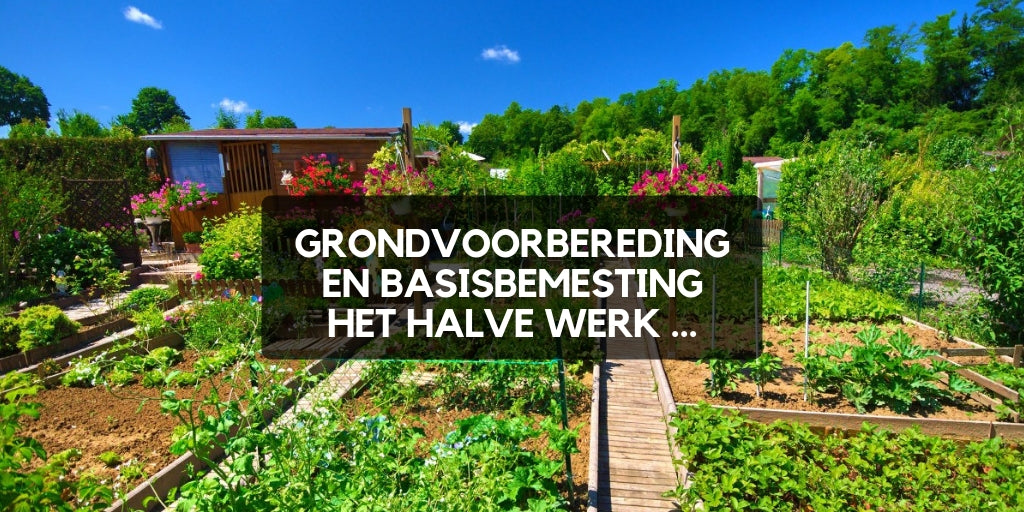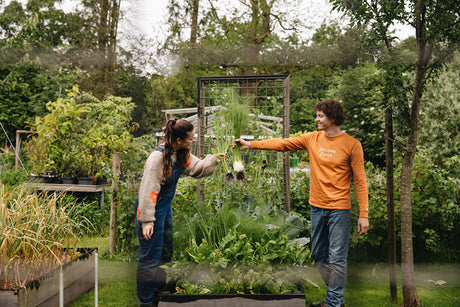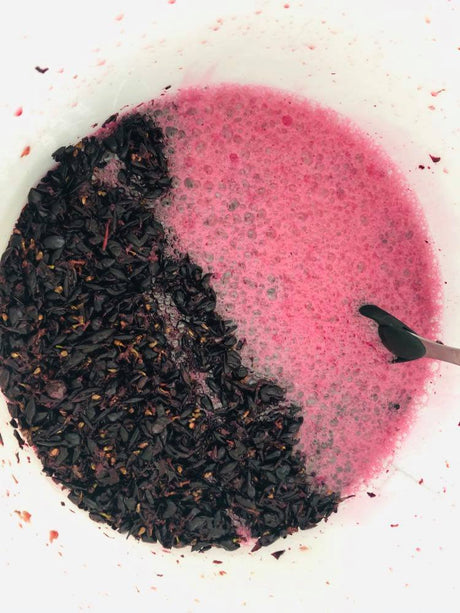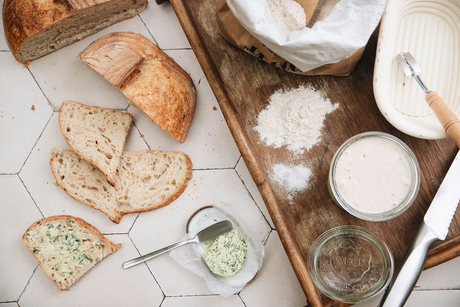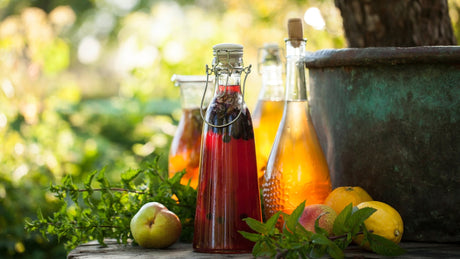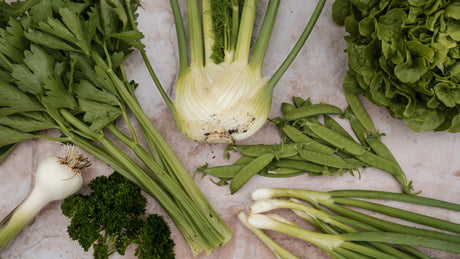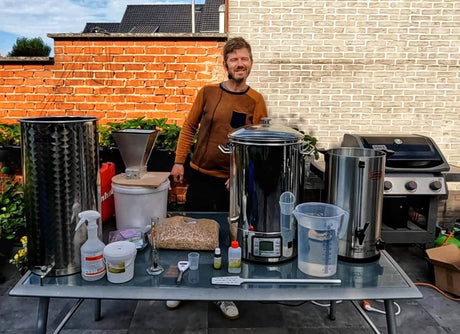Soil preparation and basic fertilization in your vegetable garden
Provide good basic soil preparation and you will grow healthy, nutritious vegetables and beautiful flowers year after year.
It's often said, "Don't feed your plants, feed your soil." This is a truism that rings true. Last year, I wrote an ebook about the structure of vegetable garden soil. You can download it for free via this link. In this article, however, I'll take a much more practical approach and try to explain step by step what you can do.

Healthy soil is the foundation for healthy plants. When your vegetable garden soil is in top condition, you also need fewer pesticides. "When you make your vegetable garden soil healthier with good soil preparation, you also make yourself healthier" (Frank Tozer, respected gardener). Organic soil is rich in humus. Humus is the end product of soil life that gets to work on leaves, grass clippings, wood chips, etc. It's the black gold of your vegetable garden and retains moisture well, yet is loose because there's also sufficient air in your soil. As if there's glue in your vegetable garden soil (don't do that, add glue :)). After good soil preparation, your soil is full of useful minerals, which ensure very strong plants. A good vegetable garden soil interacts with living creatures in your soil, earthworms, fungi, and beneficial bacteria that are the fitness enthusiasts of your vegetable garden. They keep your vegetable garden in top condition and also maintain the acidity (ph) of your vegetable garden. So, gardening enthusiasts, how to know if your vegetable garden soil is in top shape and what you can do to get it in top shape, you can read below.
How to determine the health of your vegetable garden soil
What is in healthy soil?
Your vegetable garden soil contains approximately 17 very important elements. Nitrogen, phosphorus , and potassium (also called Potassium) are the primary nutrients, or macronutrients. This is because plants absorb the most of these three delicious vegetables. When you buy fertilizers, these three macronutrients are clearly listed on the packaging. In addition, there's calcium, magnesium, and sulfur. These three nutrients are also called secondary nutrients and are also very important for many plants. Finally, there are micronutrients such as boron, copper, iron, manganese, zinc, and cobalt, which are not absorbed by all plants and often have very specific functions. Cobalt, for example, is only used by legumes to add nitrogen to the soil. Crop rotation is therefore also done for a reason. Besides the nutrients that are very important in your vegetable garden soil, there's something you should definitely test when preparing your soil: the acidity of your soil, expressed in pH. If the pH in your vegetable garden is too high or too low, your fruits and vegetables may feel nauseous and unable to swallow a bite. Of course, your plants don't have throats, but you get the idea.

pH Acidity in the vegetable garden
When preparing your vegetable garden soil, test it
You can have your soil tested by a soil science service in your region. I did this once when I moved into a new plot of land in 2015. That's very interesting. A soil science service can provide very detailed information. For example, I also had my soil tested for heavy metals. Below is a summary of my vegetable garden soil, which at the time was a sandbox without humus or organic matter.

I had this test performed by the Belgian Soil Service. There's probably a service in the Netherlands that can do this too. A basic test costs around 80 euros, but depending on how much you want to test (for heavy metals, for example), it can cost a bit more. You have to take soil samples from six locations, put them in a bag, and send them in. You'll receive the results two weeks later. There are also self-test kits that allow you to fairly accurately determine the NPK (nitrogen, phosphorus, and potassium) and pH values in your vegetable garden during soil preparation. A box containing 10 tests costs between 20 and 50 euros. Moestuinweetjes requested sample test kits from several companies. It would be a good topic for a video on Moestuin TV to compare these testers. We can then include the best ones in our online store . If you'd like to read more about soil acidity in the vegetable garden, you can follow this link. You can adjust your soil acidity with compost (to make the soil more acidic) or seaweed lime (to make it less acidic). The best time to test your soil is in the fall or spring, just before adding soil amendments or fertilizer. Important: Nutrient values, acidity, mineral content, humus levels, or carbon levels can be approached very scientifically and mathematically. You can also use common sense, observe your vegetable garden and see what's happening, and go by feel. I'll share what I know about soil preparation and fertilization.
How to prepare soil and add fertilizers
You can read how a vegetable garden soil works in the ebook I wrote: My Organic Vegetable Garden . In this article, I'll take you step by step through what we need to do to create a vegetable garden teeming with healthy, home-grown vegetables.

The basics of soil preparation: Improving soil structure, adding soil conditioner with organic matter that becomes humus...
Gardening in a sandbox or on a clay block isn't good. In a sandbox, water simply flows right through the soil, washing away a lot of nutrients. On a clay block, the water stays stagnant, and your plants rot. To create a fertile, grow-friendly garden soil, we first need to address the structure and create a system that converts soil life into humus. Humus is a ready-made, nutrient-rich food for your plants. Especially the micronutrients that are harder to provide with organic NPK fertilizer pellets are found in humus. Humus is the decomposition of organic material (twigs, leaves, plant debris, animal manure, dead animals, etc.) and contains nutrients you can't buy in a box.
compost or manure provides organic material that becomes humus
A soil rich in organic matter teems with soil life (worms, small animals, beneficial fungi, and beneficial bacteria) that constantly produce humus. What an earthworm produces is pure humus, while what a fungus converts into humus is gastronomical for your vegetables. If you see lots of earthworms in your potato bed, for example, while turning or planting, start dreaming of plump, plump potatoes . Your soil is full of humus and nutrients, and, very importantly, humus retains a lot of moisture, which can be very useful during periods of drought.

This horse from my neighborhood gives me manure for my vegetable garden, a win-win situation with the owner.
When do your soil preparation with what and when?
You can prepare your soil in the fall and early spring. In the fall, you primarily use organic matter with a very intense composition, such as fresh manure or fresh compost . The intensity of, for example, chicken manure will be weakened by rain and wind during the winter. The straw from manure will decompose in the soil during the winter. Banana pieces or wood chips from your compost that haven't fully decomposed yet still have plenty of time to decompose. You can, of course, also use decomposed compost in the fall. The compost we offer in our online store with Moestuinweetjes is largely decomposed and a bite - sized morsel for your soil life and vegetables. You can incorporate decomposed compost immediately with a vegetable spade in the fall, and you can also use this bite-sized vegetable garden treat in the spring. Fresh compost and fresh manure, which you add while steaming in the fall, are best left on the soil in a thick layer. If the decomposition process in your soil needs to continue, it will also take nutrients from your soil, which isn't ideal. A layer of compost or manure for the winter is ideal. Some gardeners lay a layer as thick as 10-20 cm. The soil life will nibble at your manure or compost and convert it into nutrients for your vegetables. In the spring, you can then incorporate the thinner layer of manure or compost with a pitchfork or vegetable spade .
Use plenty of compost and/or manure in your vegetable garden for a few years, and your sandbox or clay block will become a beautiful, rich, well-structured, black soil suitable for growing anything. The pH will be balanced between 6.0 and 6.8, allowing you to grow almost anything. https://youtu.be/Ou1uESve-yU In this video, Peter from Moestuinweetjes and I prepare my soil (autumn 2015)
It is better to feed your vegetable garden soil even more with organic fertilizer granules in the spring or when planting out
With what you've learned above, you already have the following in your soil: air (work in compost or manure), water (humus and organic matter retain moisture better in your soil), soil life (as long as soil animals have organic matter on their menu, air, and moisture, they stay in your soil), and humus (the black gold for strong plants, decomposed organic matter that's a delicacy for beautiful, strong plants with green leaves, strong roots, and beautiful fruits). With this soil preparation, you can go to war; the vegetable garden season can begin. You can use everything you read for all your beds. You can take on the world. But you're not there yet. A wise man once told me: "If you think you've made it, you're dead." That's true for everything you want to grow. A relationship, a family, a business... The moment you lean back and say: "I'm there, now the rest of the growth will happen automatically"... very dangerous. We still have to apply crop protection, we have to keep weeds under control, and we also have to be vigilant about watering on time during droughts and in the greenhouse or polytunnel. But our passion for vegetable gardening drives us in that direction. That last visit to the young lettuce plants under the screen light, or clearing a small plot to plant sweet potatoes tomorrow... it's wonderful.
Fertilizers in the vegetable garden during soil preparation
The manure and compost currently in the soil will benefit all your crops. The foundation is there. If, like me, you practice crop rotation , you can consider what else is needed for each bed to optimally nourish the vegetables you want to grow in that specific bed. Good news: in the legume bed, you have little work to do. The fresh manure and compost from the fall and the decomposed compost and manure you added in the spring are more than enough for growing. You don't need to do anything extra. But in the other beds, you can, and in some cases, should, add additional nutrients. Before we start on fertilizers: I work with organic fertilizers and recommend small amounts. Overfertilizing is unnecessary, especially if your base ( compost /manure) is good. Always check the packaging for the manufacturer's recommended amount. Be aware that this is often a bit excessive and doesn't take into account the nutrients already present in your vegetable garden soil. For soil that is depleted after growing crops like cabbage, pumpkins , potatoes , and tomatoes, it's best to use the manufacturer's recommended amount. My 4 most popular fertilizers:
The classics, Epsom salt and seaweed lime
Two products that can be very useful are essential when preparing the soil. Every vegetable benefits from Epsom salt, also known as Epsom salt or magnesium sulfate . You can read about it and its effects in an article I wrote: Epsom salt, magnesium sulfate, or Epsom salt – The dirt-cheap secret . You can apply Epsom salt in its pure form during soil preparation at 50-100 grams per square meter where you plan to sow. For crops you plant out, I usually add a tablespoon to the planting hole, which I mix thoroughly with the soil before planting. So, I make my planting hole slightly larger than the root ball of my plant and work the Epsom salt in with a small shovel. Then there's seaweed lime , which naturally contains calcium, but also magnesium and numerous micronutrients that will keep your soil in top condition. Lime also helps prevent clubroot, a disease affecting cabbage varieties, and strengthens your plant's cell walls, thus preventing blossom end rot in tomatoes, peppers , and bell peppers . 80 grams per square meter (two handfuls if you have average-sized hands) and your soil will be in top condition. If you have a very high pH (acidity) in your garden, avoid adding too much lime . Above 7.0, I wouldn't recommend adding seaweed lime . More about acidity in your vegetable garden, in this article: pH acidity in the vegetable garden
How do I apply organic fertilizer granules, lime and Epsom salts when preparing the soil?
We add compost and manure before working the soil 25 cm (with a pitchfork) to 50 cm (with a double-row spade) with a spade or vegetable spade. However, I don't add the organic fertilizer granules before digging, but between turning or digging and raking. I only use the pitchfork, so I only work the top 25 cm of my vegetable garden soil. Here's how I do it.
- Spreading mushroom compost, compost , or manure over my beds. If I do this before winter, I leave it there all winter until March. If I don't spread my compost and manure (decomposed in that case) over my beds until March, I immediately move on to the next step.
- I take my spading fork and turn the soil thoroughly (see video). The compost is now well-distributed not only lengthwise and widthwise, but also deep down. However, the soil is in lumps and air pockets, so I still need to break it up.
- But before I break up the soil, I add organic fertilizer pellets. 40 to 200 grams per square meter, depending on the crop.
- Then I roughly till everything with a rake or crowbar and finely till everything with a cultivator with 3 or 5 tines or a fine rake , depending on the crop. You'll understand that the bed for sowing carrots is a bit finer than the bed where I'll be growing pumpkins .
Liquid manure and manure pellets
I use both, and I know that liquid fertilizer is generally faster to absorb than fertilizer pellets, but it also washes out faster in your garden. Applying liquid fertilizer for fruit crops in your garden shed or greenhouse for your tomatoes in October is a waste of time and money; during full bloom and fruiting, it's a brilliant idea. Sounds logical, doesn't it? Fertilizer pellets are slower to work and often take a few weeks to break down sufficiently and be absorbed by your plants. I would also recommend adding fertilizer pellets in the spring or when planting out.
Extra fertilizer granules for potatoes
In addition to the compost and manure, which are packed with organic matter and hopefully also contain wriggling earthworms and other soil creatures, beneficial fungi, and bacteria, I also add a large amount of organic potato fertilizer pellets , which will further enhance your potato harvest. This way, you'll get the best results from the available vegetable garden space.
Give cabbage crops extra fertilizer granules
You can give the cabbages more compost and manure than your other beds, as most cabbage varieties are large feeders and require a lot of energy to develop their heads. Therefore, you can add an extra nitrogen-rich organic fertilizer at planting time. Universal organic fertilizer pellets for the vegetable garden are excellent for all cabbage crops. If you have some cow manure pellets available, you can also incorporate them into your soil preparation. Even though cabbages like a lot of nutrients, don't overdo it and check the packaging carefully. Too much fertilizer can cause diseases and poor growth in your cabbage.
Give leafy vegetables an extra boost
If you've used a lot of compost or manure, the soil already contains a lot of nutrient-rich organic matter, but a small amount of universal organic fertilizer pellets for the vegetable garden will help your leafy vegetables grow even better. I use 0 to 100 grams of pellets per m², depending on how much compost I've been able to apply. When fertilizing your leafy vegetables, be careful not to overdo it, as excess nitrogen converts to nitrates in the plant, which is undesirable.
Add fertilizer granules to fruit crops when preparing the soil
Fruit crops are very diverse. You have monster pumpkins that weigh over 100 kilos and deplete your entire soil, and then there are peppers that require very little nutrition. The trick is to dose. I use organic fertilizer pellets for tomatoes, fruit crops, and greenhouse plants . For fruit crops, the Epsom salts (also called Epsom salts or magnesium sulfate ) I mentioned earlier is also very important for plants with beautiful, deep green leaves. Deep green leaves promote optimal photosynthesis, a process that converts sunlight into sugar (simply put). This sugar produces the best tomatoes. For fruit crops, I also add 50% of the fertilizer pellets, lime , and Epsom salts during soil preparation, and 50% directly to the plant's roots in the planting hole.
Additional fertilizer for root crops
- Carrots and parsnips don't benefit from nitrogen; on the contrary. Carrots develop a lot of foliage but few roots. Moreover, hairs develop on the roots, which then seek out nutrients more shallowly. And that's not what we want. Roots should be deep and long. What you can add is a handful of phosphorus (40 grams) per 0.5 linear meters of carrots, spread into your well-worked soil. Phosphorus is available in the form of bone meal .
- Beetroot : Beets are good eaters and benefit from 60 grams of universal organic fertilizer granules per square meter when preparing the soil. If you grow beetroot young and intend to eat it, shaped like a ping-pong ball, you don't need to fertilize. For larger beets, fertilize them again one month before harvest with Vinassekali to ensure large tubers.
- fennel : you can start fennel in the same way as beetroot with 60 grams

